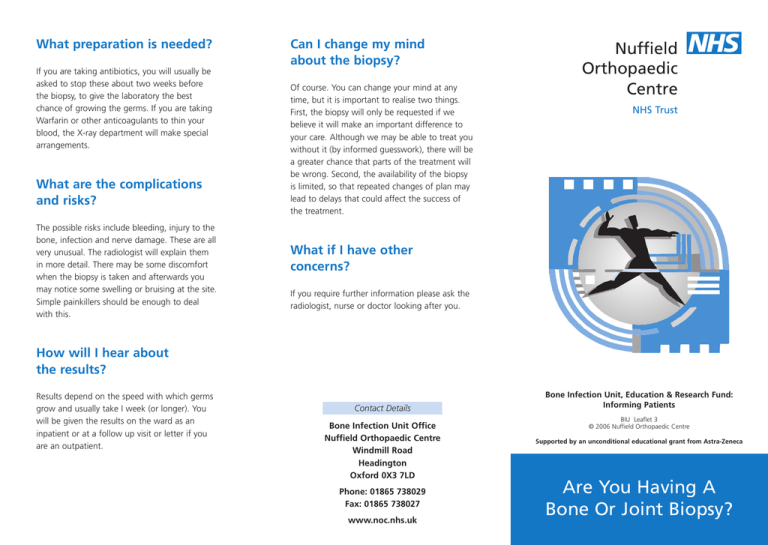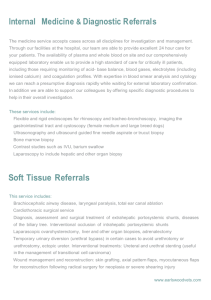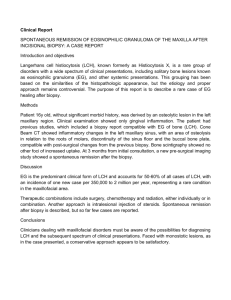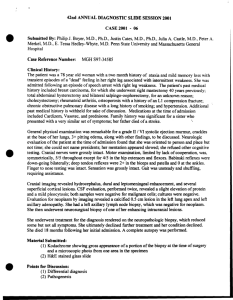n Nuffield Orthopaedic Centre
advertisement

What preparation is needed? If you are taking antibiotics, you will usually be asked to stop these about two weeks before the biopsy, to give the laboratory the best chance of growing the germs. If you are taking Warfarin or other anticoagulants to thin your blood, the X-ray department will make special arrangements. What are the complications and risks? The possible risks include bleeding, injury to the bone, infection and nerve damage. These are all very unusual. The radiologist will explain them in more detail. There may be some discomfort when the biopsy is taken and afterwards you may notice some swelling or bruising at the site. Simple painkillers should be enough to deal with this. Can I change my mind about the biopsy? Of course. You can change your mind at any time, but it is important to realise two things. First, the biopsy will only be requested if we believe it will make an important difference to your care. Although we may be able to treat you without it (by informed guesswork), there will be a greater chance that parts of the treatment will be wrong. Second, the availability of the biopsy is limited, so that repeated changes of plan may lead to delays that could affect the success of the treatment. Nuffield Orthopaedic Centre n NHS Trust What if I have other concerns? If you require further information please ask the radiologist, nurse or doctor looking after you. How will I hear about the results? Results depend on the speed with which germs grow and usually take I week (or longer). You will be given the results on the ward as an inpatient or at a follow up visit or letter if you are an outpatient. Contact Details Bone Infection Unit Office Nuffield Orthopaedic Centre Windmill Road Headington Oxford 0X3 7LD Phone: 01865 738029 Fax: 01865 738027 www.noc.nhs.uk Bone Infection Unit, Education & Research Fund: Informing Patients BIU Leaflet 3 © 2006 Nuffield Orthopaedic Centre Supported by an unconditional educational grant from Astra-Zeneca Are You Having A Bone Or Joint Biopsy? Introduction This leaflet has been written for patients requiring a bone or joint biopsy for possible infection. This leaflet explains what this involves and the part this plays in your treatment. What is a biopsy? A biopsy involves taking one or more small samples of tissue from a part of the body in order to do tests on the samples. Why do I need a biopsy? You have been referred to the Bone Infection Unit for investigation and/or treatment of a suspected or definite infection of a bone, joint, artificial joint (joint replacement) or orthopaedic metalware (such as a pin or plate to help a fracture heal). Sometimes, to decide whether infection is present, or to decide on the correct antibiotics, it is necessary to take samples of tissue for tests. This is so we can grow the germs and give you the best antibiotic treatment possible. What tests are done on the tissue? Two kinds of tests are done on the samples to give the most accurate result possible. Some of the tissue sample is set up for culture in the Microbiology laboratory. This is to attempt to grow the germs responsible for the infection. Some of the sample is sent to the Pathology laboratory to be examined under the microscope. This is to look for the signs of infection within the tissue. How will the biopsy be organised? The biopsy is performed in the X-ray department by one of our musculoskeletal radiologists (doctors specialising in taking and interpreting images of the skeleton, and in performing certain kinds of investigation and treatment). We request the biopsy from the X-ray department. You will receive an appointment by post if you are an outpatient. If you are an inpatient in hospital, the nursing or medical staff will let you know when the biopsy is going to happen. How is the biopsy done? When you attend the X-ray dept. the procedure, risks and complications will be explained. You will be asked to sign a form to confirm that you agree to a biopsy. The biopsy will be performed under ‘image guidance’ involving an ultrasound scanner, or a special X-ray, before and sometimes during the biopsy. This is to increase the chance of safely obtaining the right samples. The skin is then cleaned with antiseptic to kill germs. Sterile drapes may be used to provide a clean area. An injection of local anaesthetic will numb the skin. A needle is passed through the numbed skin to take a small sample from the bone, or around the orthopaedic implant, that might be infected. If possible, a number of samples will be taken, as we find this makes the tests more reliable. There may be some temporary discomfort when the biopsy is actually taken; you can discuss this with the radiologist if it is too uncomfortable. After the biopsy there will be a small dressing over the biopsy site, which you will be asked to keep clean, dry and covered for a couple of days.








